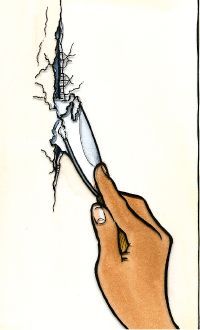Key Takeaways
- Plaster walls, common in older homes, are durable and visually appealing but prone to developing cracks over time.
- Repairing plaster cracks effectively often requires enlarging the cracks before filling them with plaster of Paris or a premixed plaster repair compound to prevent recracking.
- The repair process involves cleaning out loose plaster, applying and smoothing the plaster compound, allowing it to dry thoroughly, and then sanding and painting the wall for a finished look.
Older homes often have lath-and-plaster walls. Plaster is both a durable and good-looking surface, but there is one drawback: Plaster inevitably develops cracks.
Latex paint will hide hairline cracks in plaster, at least temporarily. The coverup, though, may last only a few hours or a few months. Small plaster cracks have an annoying way of showing up again and again. It may be smarter to enlarge them and fix them properly once and for all.
Advertisement
Making a small flaw bigger may sound like reverse logic, but it's easier to fix big cracks in plaster than small ones. Use plaster of paris, which doesn't shrink as it dries, or purchase premixed plaster repair compound. Repairing large plaster cracks involves these steps:
Step 1: Cut away loose plaster with utility knife. Turn knife to make opening wider and more clean-lined. Remove debris while preserving structural integrity of surface around it. Clean away loose plaster and dust with vacuum cleaner.
Step 2: Mix thick paste of plaster of paris and water, and wet crack thoroughly with paintbrush dipped in water. Pack plaster of paris (or repair compound) into wet crack to its full depth, and smooth surface with scraper or trowel. Let filled crack dry at least 24 hours.
Step 3: Lightly sand patch when plaster is dry with medium-or fine-grade sandpaper wrapped around wood block. If crack was wide, replaster it at least once more to make surface smooth, rewetting plastered area each time. Let area dry for at least 24 hours after final plastering.
Step 4: Lightly sand patch again, and prime it with thinned coat of paint or primer. When primer is dry, paint entire wall.
Advertisement
